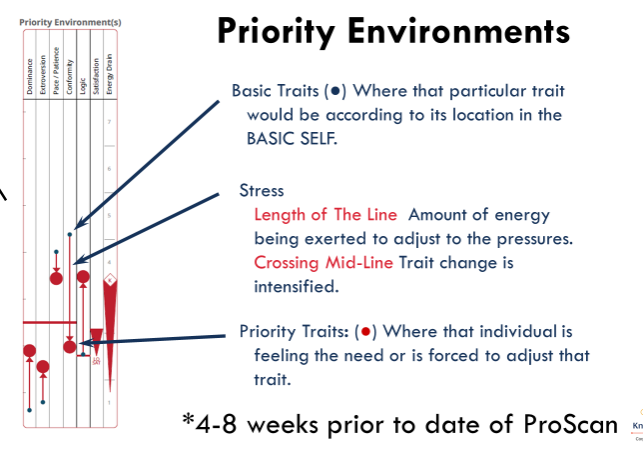
It’s all about Priorities!
Priority Environments that is…

So what is the Priority Environment? It’s a measure of something occurring in a person’s environment over the past 6-8 weeks that caused them to feel the need to adapt their behavior. Beside the shifts in behavior, such as pushing Dominance up or lowering Extroversion, the Priority Environment “graph” also reports how much energy drain the adaptations required and how much satisfaction was derived from the experience.
It other words, it shows how a person had to adapt their natural behavior, how much energy it took and whether they felt like it was worth it or not! The pressures could come from work or elsewhere (such as finances, health, social life, etc.).
Why, you may ask, is this such a big deal? Because the Priority Environment graph gives employers, HR leaders and managers insight into how well their people are doing, how much available energy they have, and if they are feeling rewarded for their efforts.
How do we assess our own Priority Environment?
By completing PDP Globals’ behavior survey, the ProScan, which is a simple 60 question survey that produces a “priority environment” graph/report as part of their results.

PDP Global’s ProScan is the behavior survey used by Know Your Talents. We integrate it into every aspect of our consulting services to help companies enhance their culture and optimize employee performance at every level in the organization.
Last week, PDP Global, the creator of ProScan, held their annual conference via Zoom. Not only did we get to learn about the latest developments, upgrades, and enhanced reporting, but we also drilled down to the nuances of the Personal Dynamic report, the one most commonly used by companies, HR leaders, hiring managers, supervisors, and teams. It became apparent that one very unique aspect of the ProScan topped the list over and over again…the Priority Environment.
Not surprisingly this is the same feedback that we often receive from our clients. Our parent company, LearnKey, has also been using ProScan for years in a program called “ProScan to Placement” which helps disabled veterans complete online courseware mapped to professional certifications and ultimately getting them great jobs.
Here is an example of how to leverage this in an organization: Let’s say a manager notices that someone’s performance or demeanor has shifted, the Priority Environment invites them to engage in a conversation with the individual about how to support them so they don’t burn out and go away. It can also be used in the hiring process to give HR leaders line of sight to what candidates might be “bringing with them” into their new position. Of course it’s important for managers to have a conversation with candidates to better understand the cause for the Priority Environment results.
The Priority Environment measurement and reporting is unique to PDP’s ProScan. It is one of the many reasons KYT chose PDP 20+ years ago and is still a huge believer in them today.
We exist to help our clients maximize their most valuable asset, their people. PDP Global and ProScan are helping us do that every day.


